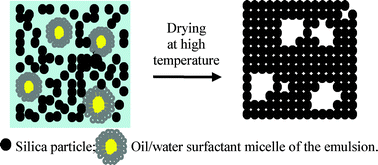We report a soft and straightforward method for synthesizing two- and three- dimensionally patterned silicate materials by phase separation using nonionic emulsion templates. Our liquid-state method involves, under controlled atmosphere, the mixing of a condensed silica solution with an oil-in-water emulsion in the presence of a solution of a nonionic emulsifier, Triton X-100. The preparation is stabilized using an organic solvent. The morphology of the silicate materials is significantly modified by changing the reaction conditions or the concentration of the reagents. Three-dimensionally macro and nanoporous continuous films and nanoporous individual spherical particles, both made of amorphous silica, are obtained. The structure of the films and particles is defined by the emulsion template. Films were on average 20 μm thick with a volume-based porosity of ∼7 × 10−2 cm3 g−1, with pore size correlating well with the size of the oil droplets in the templating emulsion. The siliceous films are bicontinuous leading to large surface areas and openly accessible pores. Individual spheres ranged in size from ∼1 to 6 μm in diameter with nanoporous openings of 300 nm in diameter. The porosity and integrity of all materials are maintained upon calcination.

You have access to this article
 Please wait while we load your content...
Something went wrong. Try again?
Please wait while we load your content...
Something went wrong. Try again?


 Please wait while we load your content...
Please wait while we load your content...